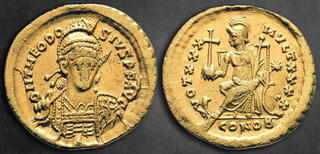Lot description:
Theodosius II AD 402-450. Constantinople
Solidus AV
21 mm, 4,40 g
D N THEODO-SIVS P F AVG, pearl-diadmed, helmeted, and cuirassed bust facing slightly right, holding spear over shoulder in right hand and shield decorated with horseman motif in left / VOT XXX MVLT XXXX I, Constantinopolis enthroned left, with left foot on prow, holding globus cruciger in right hand, scepter in left, star to right, CONOB in exergue.
Very Fine
RIC X 257; Depeyrot 81/1.
Theodosius II, known as Flavius Theodosius, was a prominent Roman Emperor who reigned over the Eastern Roman Empire, which would later become the Byzantine Empire, from AD 408 to 450. His ascent to the throne was unique, as he took on the mantle of leadership at the young age of 7 following the death of his father, Emperor Arcadius. Due to his youth, Theodosius II was placed under the guardianship of various regents during the early years of his reign. What sets Theodosius II apart in history is the remarkable length of his rule, spanning over four decades. Throughout his reign, he heavily relied on the counsel and guidance of advisors and regents, especially during his formative years as a ruler. One of his most enduring contributions was the construction of the famous Theodosian Walls that fortified the city of Constantinople, the Byzantine capital. These formidable defenses played a pivotal role in safeguarding the city from numerous external threats, including barbarian invasions. Theodosius II was a devout Christian, and he actively supported the Nicene Creed, an important doctrine of Christian orthodoxy. He also played a significant role in ecclesiastical matters, such as the convocation of the Council of Ephesus in 431, aimed at addressing theological controversies of the time. His reign also saw the initiation of efforts to compile and organize Roman laws, resulting in the creation of the Theodosian Code. This legal code became a vital source of Roman law for both the Eastern and Western Roman Empires, as well as for medieval Europe. In terms of relations with the Western Roman Empire, Theodosius II had a complex connection with his counterpart, Emperor Honorius. The Western Empire was grappling with internal strife and external threats, notably the Visigothic and Vandal invasions. Theodosius II provided limited assistance to Honorius, reflecting the challenges faced by both empires during this period. Theodosius II's reign came to an unfortunate end in 450 AD due to a riding accident. He was succeeded by Marcian, who was married to Theodosius II's sister Pulcheria. Theodosius II's long and relatively stable rule played a crucial role in preserving the Eastern Roman Empire during a time of considerable external pressures and internal complexities. His legacy endures through his significant contributions to law, fortifications, and the Christian tradition of the Byzantine Empire.
Starting price: 200 EUR |  |